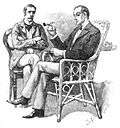The Story of the Lost Special
| "The Story of the Lost Special" | |
|---|---|
| Author | Arthur Conan Doyle |
| Country | UK |
| Language | English |
| Series | Sherlock Holmes (implied) |
| Publication date | 1898 |
"The Story of the Lost Special", sometimes abbreviated to "The Lost Special", is a short story by Arthur Conan Doyle first published as part of the Round the Fire series in The Strand Magazine of August 1898. It is implied to be a Sherlock Holmes story, though his name is not used. The story's narrative mode is third person, subjective, though the narrator is not identified.
Synopsis
This story concerns the baffling disappearance of a privately hired train (a special) on its journey from Liverpool to London on 3 June 1890; besides the train crew of driver, fireman, and train guard the only passengers are two South Americans. The train is confirmed to have passed Kenyon Junction but never have reached Barton Moss. The only clues are the dead body of the engineer found among the train tracks past Kenyon Junction and a letter from the United States that purports to come from one of the missing train crewmen. Authorities fail to discover any traces of the train. A letter to The Times by "an amateur reasoner of some celebrity at that date" is excerpted at one point, the style of which suggests that the author is probably Sherlock Holmes. This "recognized authority upon such matters" suggests that the train and its passengers are destroyed by a criminal organization comparable to Camorra on one of the three active side tracks leading to active mines. The proposition meets with heated opposition, although the objectors fail to supply any conceivable alternative. Nevertheless, the responsible authorities do not act on the proposal and the public never shows any interest as a political scandal has already attracted their attention. Other than writing the article Holmes takes no action in the case, and the solution is not due to his investigation.
Eight years later, a criminal mastermind called Herbert de Lernac, scheduled for execution in Marseilles, confesses to the crime. A conspiracy of men had temporarily re-attached the side track leading to the abandoned mine Heartsease just long enough for the train to go down to the mine, then pulled the tracks back up before they could be discovered. The police, as well as the "amateur reasoner", had dismissed the side lines leading to abandoned lines because the railway had removed the connecting tracks and did not consider the possibility of anyone else laying down tracks. Herbert suppresses the names of his employers in this confession, but threatens to reveal their names if he is not granted a pardon. Doyle does not tell whether or not his blackmail succeeded in gaining him that pardon.
De Lernac mentions that, since he did not know the specific British conditions needed for his plot, he had recruited the help of a highly resourceful British master criminal. This might have been Professor Moriarty. The story is set in 1890, one year before "The Final Problem" setting out the final confrontation between Holmes and Moriarty.(A special train also appears in the plot of that story.)
Another fictional railway mystery by Arthur Conan Doyle, "The Story of the Man with the Watches", is an 1898 locked room mystery in which an unknown man is found in a railway compartment with six watches; an unnamed criminal investigator theorizes a solution to the mystery.[1]
Adaptations
- The Sherlock Holmes pastiche series Solar Pons by August Derleth treated the story as canon with its own version of the story, The Adventure of the Lost Locomotive.
- The story was loosely adapted into the serial The Lost Special (1932) as a western.
- The story was adapted as a 1943 episode of the radio program Suspense.
- The story was adapted as an episode of the radio program Escape which aired February 12, 1949. While the episode includes several letters to the Times, the one sometimes attributed to Sherlock Holmes is not among them.
- The 1941 crime film The Great Train Robbery uses essentially the same method for causing the disappearance of a train between stations as "The Lost Special." Conan Doyle's story is not credited as the film's source material, and Sherlock Holmes is not, either explicitly or implicitly, consulted.
- A very faithful adaptation was done in 1980 for Radio Mystery Theatre as "The Mysterious Rochdale Special".
- The 1986 DC Comics limited series Watchmen includes possible references in theme of hiding a great secret of world significance, with a character named Jane Slater as acknowledgment.
- A similar scenario appears in the 2014 video game Sherlock Holmes: Crimes & Punishments. The correct solution is changed from the one in the story, but all the relevant elements remain.
- The Sherlock episode "The Empty Hearse" features a car on the London Underground vanishing between two stations.
References
| Wikisource has original text related to this article: |
External links

